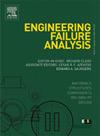Experimental study on the failure characteristics of the loess high slope under the coupled effects of soil Consolidation, Rainfall, and evaporation
IF 4.4
2区 工程技术
Q1 ENGINEERING, MECHANICAL
引用次数: 0
Abstract
The stability of loess high-fill slopes is a crucial issue in engineering, where the presence of fissures significantly impacts slope stability. This study investigates the seepage-mechanical response and fissure evolution characteristics of loess high-fill slopes under the coupled effects of consolidation, rainfall, and evaporation through model testing. The disaster chain evolution process of the slope under these coupled effects is revealed. The results show that the development of fissures in loess high-fill slopes does not follow a directional pattern and has a uniform influence on soil properties. Under rainfall, the slope exhibits preferential flow paths, which guide the deformation and failure modes. With the development of fissures, the fill material shows a “cumulative damage effect,” leading to progressive performance degradation and continuous decline in slope stability. This study enriches the theoretical framework for stability analysis of high-fill fissured slopes and provides guidance for disaster prevention and mitigation in loess regions.
求助全文
约1分钟内获得全文
求助全文
来源期刊

Engineering Failure Analysis
工程技术-材料科学:表征与测试
CiteScore
7.70
自引率
20.00%
发文量
956
审稿时长
47 days
期刊介绍:
Engineering Failure Analysis publishes research papers describing the analysis of engineering failures and related studies.
Papers relating to the structure, properties and behaviour of engineering materials are encouraged, particularly those which also involve the detailed application of materials parameters to problems in engineering structures, components and design. In addition to the area of materials engineering, the interacting fields of mechanical, manufacturing, aeronautical, civil, chemical, corrosion and design engineering are considered relevant. Activity should be directed at analysing engineering failures and carrying out research to help reduce the incidences of failures and to extend the operating horizons of engineering materials.
Emphasis is placed on the mechanical properties of materials and their behaviour when influenced by structure, process and environment. Metallic, polymeric, ceramic and natural materials are all included and the application of these materials to real engineering situations should be emphasised. The use of a case-study based approach is also encouraged.
Engineering Failure Analysis provides essential reference material and critical feedback into the design process thereby contributing to the prevention of engineering failures in the future. All submissions will be subject to peer review from leading experts in the field.
 求助内容:
求助内容: 应助结果提醒方式:
应助结果提醒方式:


